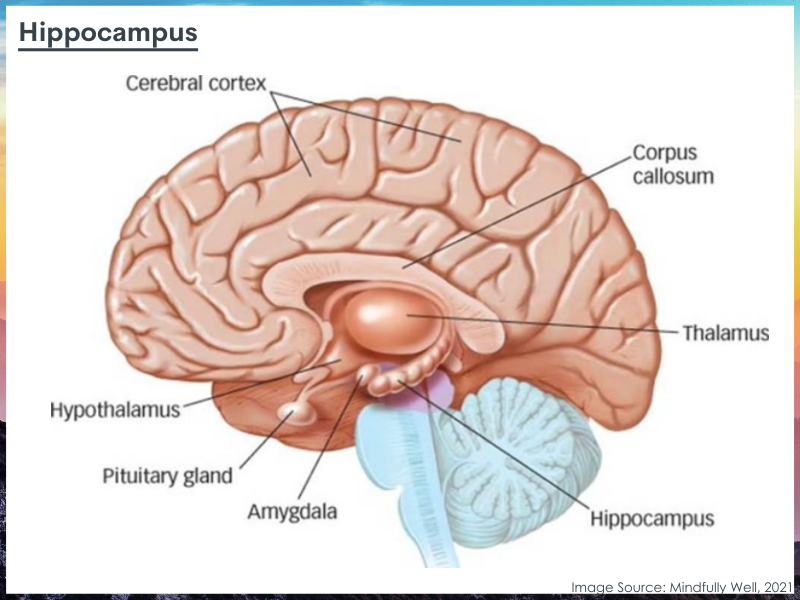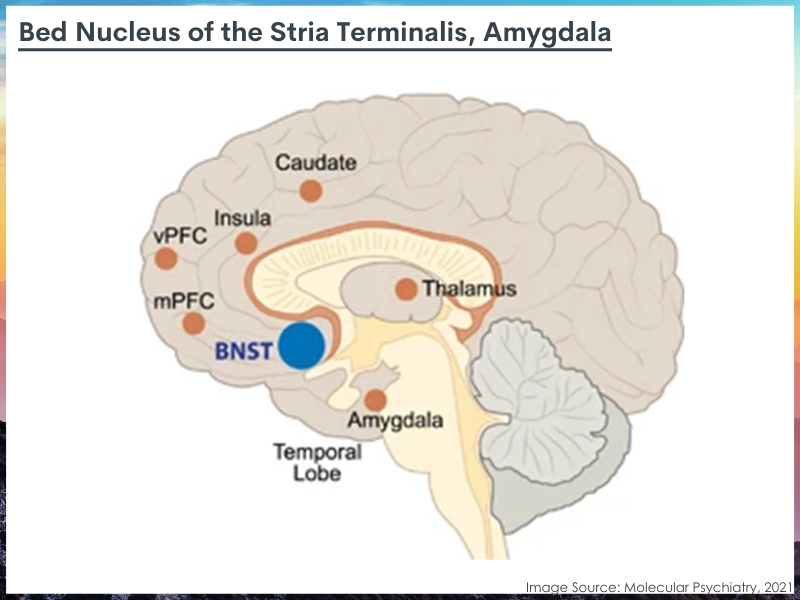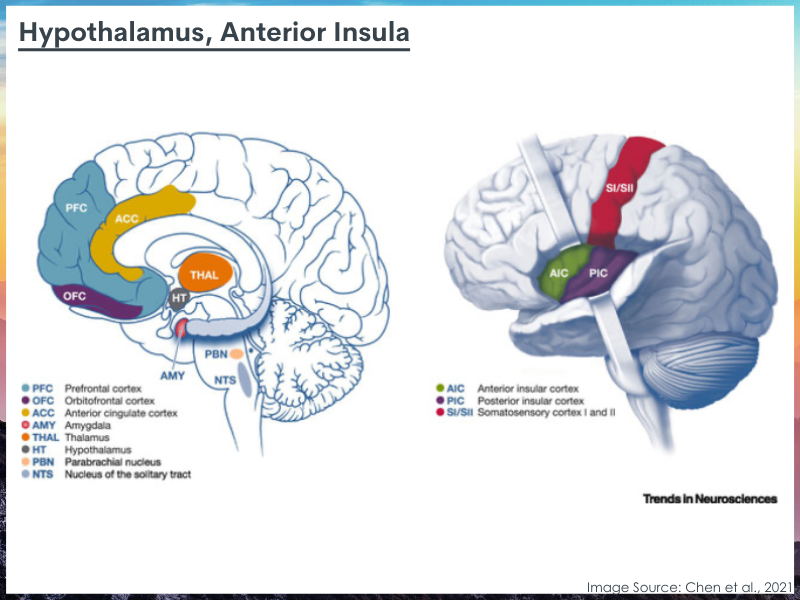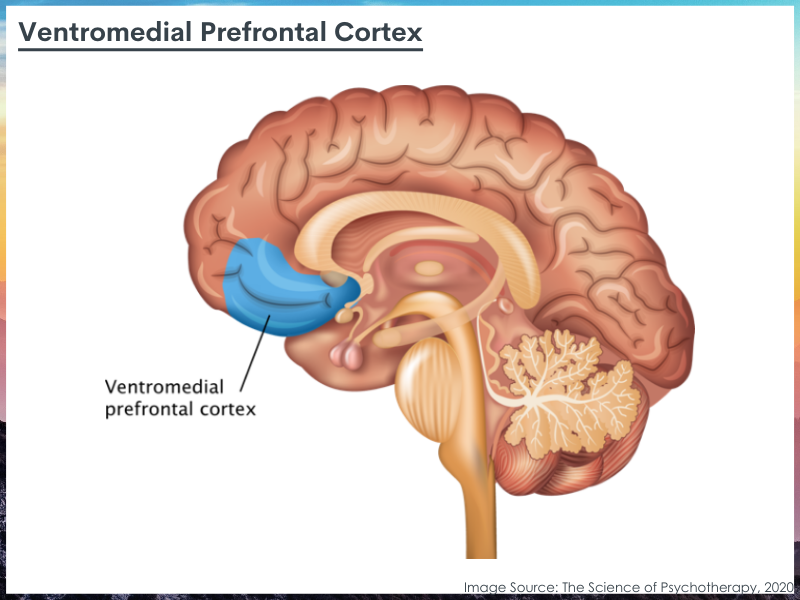Sex-specific brain connectivity during early abstinence: Implications for anxiety, stress, and alcohol use disorder
A small region of the brain, called the bed nucleus of the stria terminalis, and its connections to neighboring brain regions are shown to play a key role in arousal, stress response, alcohol consumption, withdrawal, and anxiety-related behaviors during abstinence from alcohol. Despite the relationship between stress, anxiety, and alcohol use disorder relapse, the bed nucleus of the stria terminalis has not yet been studied in individuals with alcohol use disorder. The current study is one of the first to examine the connectivity of the bed nucleus of the stria terminalis to other brain regions among recently abstinent individuals with alcohol use disorder, as well as the role of sex and the strength of these connections in anxiety symptoms and disorder severity.
WHAT PROBLEM DOES THIS STUDY ADDRESS?
The brain changes that accompany alcohol use disorder can persist during abstinence, including alterations in brain regions that play a key role in anxiety. These alterations can cause heightened stress responses in the brain and body, especially during early recovery. These heightened stress responses, in turn, can make individuals more susceptible to anxiety and reactive to stress. Since alcohol can alleviate these symptoms, individuals might seek out alcohol to cope with stress and anxiety, placing them at risk for relapse. Studying the brain alterations that contribute to heightened stress and anxiety responses during early abstinence will help reveal the structures important to these processes, and can ultimately lead to new therapies that target these brain regions to reduce heightened stress and anxiety and, in turn, help prevent relapse.
Studies using animal models of alcohol use disorder have found that a small region of the brain, called the bed nucleus of the stria terminalis, plays a key role in arousal, stress responses, and anxiety-related behaviors during abstinence from alcohol. They have demonstrated the importance of this brain region and its connections to surrounding brain areas in regulating not only anxiety, but also alcohol consumption and withdrawal. Thanks to recent scientific and neuroimaging advancements that allow us to image this very small brain structure, the bed nucleus of the stria terminalis has begun to be investigated in humans, with its structural and functional connectivity recently mapped in healthy adults.
Importantly, the strength of the connection between the bed nucleus of the stria terminalis to other brain regions is suggested to differ between men and women. However, structural connectivity of the structure to other brain regions has yet to be studied among individuals with alcohol use disorder. Given the role of this brain region in anxiety and stress, the association between anxiety, stress, and alcohol use disorder relapse, and the sex differences observed in anxiety and stress during early abstinence, clarifying 1) whether or not this structure and its connections to other brain regions are compromised in individuals with alcohol use disorder, 2) how the nature of these connections relates to alcohol- and recovery- related behaviors, and 3)if these outcomes differ between men and women are key to understanding the neurobiology of recovery while also informing innovative treatments. The current study is one of the first to examine the connectivity of the bed nucleus of the stria terminalis to other brain regions among recently abstinent individuals with alcohol use disorder, and whether these connections and their relationships to behavior differ in men and women.
HOW WAS THIS STUDY CONDUCTED?
The authors conducted a neuroimaging study to examine connectivity of the bed nucleus of the stria terminalis to 5 other brain regions among individuals with alcohol use disorder who are recently abstinent (n=19), referred to here as the early recovery group, relative to individuals with past-year alcohol consumption but no history of alcohol use disorder (n=20), referred to here as the control group. Participants were recruited from the general community. All participants were required to be free of histories of major medical illness or traumatic brain injury, and psychotic disorders. In addition, all early recovery participants met criteria for a past-year alcohol use disorder (abuse/dependence diagnosis per the Diagnostic and Statistical Manual, 4th edition) and were abstinent for 30 to 180 days. Controls had no use of psychoactive medications within the past 6 months, no lifetime history of substance use disorder, and no history of binge drinking in the past year. All controls had some degree of non-problematic alcohol consumption over the past year.
Participants completed a diffusion tensor imaging (DTI) brain scan at rest, which produces detailed images of the brain that allow for the measurement of various structural attributes (e.g., size, shape, integrity) in specific brain regions and the strength of connections between these regions. The authors assessed the strength of connectivity of the bed nucleus of the stria terminalis to 5 other brain regions relevant to alcohol use disorder or shown to have connections to the bed nucleus of the stria terminalis in previous studies: (1) Hypothalamus; (2) Ventromedial prefrontal cortex; (3) Amygdala; (4) Anterior hippocampus; (5) Anterior insula. See figures and captions below for illustrations and descriptions of these structures. The researchers were interested in the number of tracks (aka white matter connections) connecting from the bed nucleus of the stria terminalis to the 5 regions, with more tracks reflecting greater connectivity. The effects of group (alcohol use disorder abstinence vs. social drinker), sex (male vs. female), and brain region on bed nucleus stria terminalis connectivity were assessed. Connectivity was examined as the network of all connections between the bed nucleus stria terminalis and all 5 regions of interest.

Image source: Mindfully Well, 2021. This image depicts the location of the hippocampus (shown as a ribbed structure). This is a sagittal section of the brain (as if someone were facing with their forehead pointed toward the left, and the brain were cut in half from forehead to the back the head), with the hippocampus located toward the deeper, more central part of the brain and the anterior hippocampus closest to the amygdala (i.e., toward the forehead). The hippocampus is important for processing emotions, learning, and forming memories (e.g., emotional memories).
Among alcohol use disorder participants, the researchers also explored relationships between structural connectivity and:
- Anxiety: measured as a composite score (range 0-1) by combining the scores on 6 inventories (State-Trait Anxiety Inventory, Brief Fear of Negative Evaluation, Beck Anxiety Inventory, Intolerance of Uncertainty Scale, Liebowitz Social Anxiety Scale, Penn State Worry Questionnaire).
- Alcohol use disorder severity: measured with the Alcohol Use Disorders Identification Test (range: 0-40), with higher scores reflecting greater alcohol consumption and related consequences.
The majority of participants were white (72%) and about half were men (49%) and half were women (51%), with an average age of about 30 years. As expected, the early recovery group had higher scores on the Alcohol Use Disorders Identification Test with an average of 26 vs. 3 out of a possible 40, reflecting moderate to severe alcohol use disorder vs. low-risk alcohol consumption. They also had higher levels of anxiety relative to the control group based on the composite of 6 anxiety measures detailed above. Recent alcohol use, as evaluated with the quantity-frequency index (i.e., number of drinking days per month, multiplied by the typical number of drinks consumed on a drinking day), was expectedly higher among those in early recovery, with an average of 207 total drinks per month compared to controls with an average of 4 drinks per month. Early recovery participants had an average of 127 days of abstinence.

Image source: Molecular Psychiatry, 2021. The image here depicts the location of the bed nucleus of the stria terminalis (BNST, in blue) and the amygdala. This is a sagittal section of the brain (as if someone were facing with their forehead pointed toward the left, and the brain were cut in half from forehead to the back the head), with the BNST located near the forehead, or left side of the image, and the amygdala located lower and deeper in the brain, or more toward the center of the image. The BNST is a small structure in the brain that plays an important role in anxiety and stress. The amygdala is a deeper almond shaped structure that is critical for processing and remembering emotions like anxiety, fear, and reward.
WHAT DID THIS STUDY FIND?
Compared to controls, the early recovery group had stronger connectivity between the bed nucleus of the stria terminalis and the 5 brain regions of interest in women but not men.
When the network of connections between the bed nucleus of the stria terminalis and the 5 brain regions were assessed, women in early recovery showed generally stronger connectivity than controls, regardless of the brain region. This effect was not observed among men in the early recovery and control groups, who did not differ.
Regardless of alcohol use status, men and women differed in structural connectivity of the bed nucleus of the stria terminalis.
Across the early recovery and control groups, the bed nucleus of the stria terminalis was more strongly connected to the hypothalamus in women and more strongly connected to the ventromedial prefrontal cortex in men.

Image source: Chen et al., 2021. The images here depict the location of the hypothalamus (i.e., HT; shown in grey in the left figure) and the anterior insula (i.e., AIC; shown in green in the right figure) in the brain. Both images depict the brain as if someone were facing with their forehead pointed toward the left. The left image is a sagittal section of the brain, with the hypothalamus located near the middle or center of the brain. The right image reveals the insula when the outer layer of the brain is peeled back, with the anterior insula located closer to the forehead, or left of the image. The hypothalamus is important for basic functions like regulating temperature, hunger, sleep, and emotions, including stress responses in the brain. The anterior insula plays a role in a range of functions, including attention toward internal states (i.e., interoception) and regulation of anxiety-like behaviors during abstinence.
Among individuals in early recovery, disorder severity was associated with connectivity strength, but anxiety was not.
When alcohol use disorder severity scores were considered, there was an interaction between brain region, sex, and severity. More specifically, greater alcohol use disorder severity was associated with stronger connections between the bed nucleus of the stria terminalis and the ventromedial prefrontal cortex in men, though this effect did not quite reach statistical significance. In women, this relationship was reversed, with greater severity associated with weaker connections between the bed nucleus of the stria terminalis and the ventromedial prefrontal cortex, though again also not reaching statistical significance. Anxiety, on the other hand, was not associated with connectivity strength.

Image source: The Science of Psychotherapy, 2020. This image depicts the location of the ventromedial prefrontal cortex in blue. This is a sagittal section of the brain (as if someone were facing with their forehead pointed toward the left, and the brain were cut in half from forehead to the back the head), with the ventromedial prefrontal cortex located near the forehead, or left side of the image. The ventromedial prefrontal cortex plays an important role in modulating emotional responses, including anxiety.
WHAT ARE THE IMPLICATIONS OF THE STUDY FINDINGS?
Studies like this help us better understand the brain alterations that accompany alcohol use disorder during abstinence, and how brain structure influences behavioral symptoms associated with alcohol use disorder. By characterizing the structural integrity of connections between brain regions, we can better understand which regions might not be communicating as well with one another and how compromised connections relate to behavior. This can, in turn, inform the development of new medications or behavioral interventions that aim to support functioning for which these brain structures are responsible and perhaps build or rebuild these connections.
This study is the first to show that recently abstinent individuals have altered structural connectivity of the bed nucleus of the stria terminalis to other brain regions. Importantly, this effect was only observed in women, with recently abstinent women showing stronger overall connectivity of the bed nucleus stria terminalis networks compared to controls. Sex differences are typical of the bed nucleus of the stria terminalis, as this brain region is known to vary between men and women in size and function (e.g., generally stronger structural connectivity seen in women than men). This study also revealed sex differences in structural connectivity of the bed nucleus of the stria terminalis regardless of alcohol use disorder status, with men showing higher connectivity to the ventromedial prefrontal cortex and women showing higher connectivity to the hypothalamus.
Sex differences in connectivity to the ventromedial prefrontal cortex were also observed when relationships to alcohol use disorder severity were explored, with greater brain connectivity associated with greater severity in men, and greater brain connectivity associated with less severity in women. The ventromedial prefrontal cortex plays an important role in anxiety and alcohol use disorder. It’s connections to the bed nucleus of the stria terminalis are important for regulating anxiety-related behaviors. Moreover, connections between the hypothalamus and bed nucleus of the stria terminalis play a role in stress responses. Abstinence is shown to be related to greater activity of the connections between these regions, which triggers downstream stress responses that can put one at risk for relapse. Importantly, women are generally shown to have higher levels of anxiety than men during abstinence from heavy long-term alcohol use, which may also increase their risk of relapse. Therefore, reduced connectivity between the bed nucleus of the stria terminalis and the ventromedial prefrontal cortex – which might suggest difficulty regulating anxiety –combined with greater connectivity to the hypothalamus – which might suggest greater stress response – may account for the higher levels of stress and anxiety typically seen in women during abstinence, and in turn, perpetuate a return to alcohol use as a way to cope with these negative emotional states. Indeed, prior research has shown sex differences in the role of negative emotions in relapse, with the management of negative emotion playing a larger role in relapse and recovery among women. Sex-specific behavioral therapies have also been developed to better address the needs of women seeking recovery, with many recognizing the role of social support and emotional states in recovery.
Women with stronger structural connections to the ventromedial prefrontal cortex, a structure implicated in emotion regulation, may be better able to manage their drinking, thereby protecting them from developing more severe alcohol use disorders. Alternatively, heavier alcohol use and greater disorder severity may weaken this connectivity and put women at risk for altered anxiety/stress responses that increase risk relapse during abstinence. However, the current study did not find a significant relationship between anxiety and connectivity of the bed nucleus of the stria terminalis with other brain regions. The reasons for this are unclear and may be due to small sample sizes, variability introduced by sex differences (women had higher anxiety than men), or the composite anxiety scores that the researchers used to examine the association between anxiety and structural connectivity. Additional work is needed in larger sample sizes, among individuals with a range of anxiety symptoms and severities, and using various measures with high sensitivity to anxiety symptoms. Doing so will help clarify the role of the bed nucleus of the stria terminalis in anxiety, stress, and their influence on addiction and recovery in men and women.
- LIMITATIONS
-
- This study was conducted among a relatively small sample size, as is typical for neuroimaging studies in early phases of investigation like this one, and additional research with larger samples will help determine whether some of the effects and trends observed here can be replicated, or if new significant findings emerge.
- Neuroimaging results were investigated for 5 pre-defined regions to control for multiple testing. Given the limited study of the bed nucleus of the stria terminalis to date, additional research is needed to explore additional connections to other brain regions that might be affected in people with alcohol use disorder.
- The majority of participants were white middle-aged individuals. Thus, outcomes may not translate to other races/ethnicities or age groups. Although smokers were included in the study, the number of smokers to non-smokers in each group was not reported. Given that tobacco and nicotine use can have effects on brain structure and connectivity, additional research is needed to determine its role in these findings.
BOTTOM LINE
Studies like this help us better understand the brain alterations that accompany alcohol use disorder, which can ultimately inform the development of new medications or behavioral therapies that help the brain recover to support remission. This study found that, compared to drinkers with no history of alcohol use disorder, recently abstinent individuals with alcohol use disorder have generally stronger connections between the bed nucleus of the stria terminalis and the brain regions it connects to, but these differences were only seen among women. For the individuals in early recovery, stronger connectivity was associated with greater alcohol use disorder severity in men, but this was reversed in women such that weaker brain connectivity was associated with greater severity. Regardless of alcohol use disorder status and compared to men, all women had greater connectivity between the bed nucleus of the stria terminalis and the hypothalamus, a connection thought to play a role in stress responses during abstinence. These sex differences might contribute to some of the behavioral differences seen between men and women with alcohol use disorder during abstinence, including stress and anxiety responses that are more common and some evidence to suggest that emotion regulation plays an even larger role in recovery for women. Additional research will help clarify the sex-specific roles of these brain regions and their connections in alcohol use disorder, which will help in the development of individualized therapies that cater to specific populations.
- For individuals and families seeking recovery: The brain changes that are seen with alcohol use disorder can persist during abstinence, including regions that play a key role in stress and anxiety which are known to put individuals at risk for relapse. By characterizing these brain changes, we can better understand how they relate to behaviors that put individuals’ recovery at risk, and can develop new therapies that target these brain regions in an attempt to help them recover to support recovery from alcohol use disorder. Given that this is the first brain imaging study of the connectivity of the bed nucleus of the stria terminalis in humans with alcohol use disorder, additional research will help clarify its role in alcohol use disorder and potential methods to address maladaptive alterations in this brain region.
- For treatment professionals and treatment systems: Though this research is in its infancy, the bed nucleus of the stria terminalis and its connections to other brain structures show promise as new targets for the treatment of alcohol use disorder, as they might play a role in anxiety- and stress- induced relapse. The sex-dependent function and structure of this brain region may underlie greater prevalence of anxiety among recently abstinent women compared to men. Given the relationship between anxiety and relapse, additional research will be needed to determine the exact role of this brain region in the maintenance of recovery among men and women.
- For scientists: Additional research is needed to clarify the relationship between these structural connectivity alterations and behavioral implications in humans, particularly in the context of stress, anxiety, and relapse. Replication of these findings in large sample sizes and among populations with various degrees of clinical severity will help determine the applicability of these findings across different alcohol use disorder populations and will help broaden our understanding of how these connections change over the course of abstinence and are moderated by sex. Studies that look at connectivity under task conditions, as opposed to at rest, will also help clarify the role of the bed nucleus of the stria terminalis under stressful, taxing, and risky conditions which will help further inform the role of this structure and its connections in alcohol use disorder and recovery to inform new treatments that help to support remission and prevent relapse.
- For policy makers: Studies like this help us better understand the brain architecture associated with alcohol use disorder and its relationship to behaviors that hinder or support sustained recovery. This study provides evidence that a small brain structure called the bed nucleus of the stria terminalis and its connections to other brain regions may play sex-specific roles in alcohol use disorder and the anxiety/stress responses that can occur during abstinence and put individuals at risk of relapse. Such studies can ultimately guide new drug discoveries and inform new behavioral therapies for the treatment of addiction that target these brain regions to support remission. Given this is the first connectivity study of this brain region in alcohol use disorder, additional funding can help replicate and expand these findings.
CITATIONS
Flook, E. A., Feola, B., Benningfield, M. M., Silveri, M. M., Winder, D. G., & Blackford, J. U. (2021). Alterations in connectivity of the bed nucleus of the stria terminalis during early abstinence in individuals with alcohol use disorder. Alcoholism: Clinical and Experimental Research, 45(5), 1028-1038. doi: 10.1111/acer.14596

